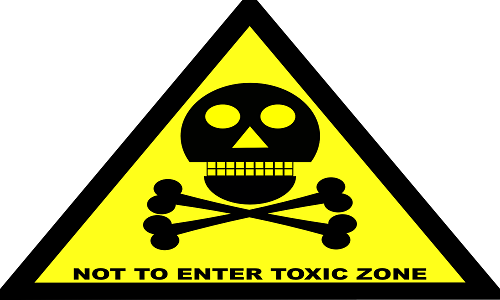Difference Between Toxic and Hazardous
What is the difference between toxic and hazardous? Both words are adjectives to mean something that might cause a person harm. We are often advised to stay away from things that are called ‘toxic’ or ‘hazardous’. These terms are used to show that the substance can damage humans, animals, plants or the environment. However, there is a slight difference in the meanings of these two similar words.
‘Toxic’ is generally used as an adjective to show that something contains or is a harmful or poisonous substance. Something toxic can cause serious illness, debilitation or even death. For example: The liquid in the bottle is toxic, so don’t touch it. When used in a medical context, it takes on the meaning of exhibiting symptoms of infection or poison. For example: The patient was toxic from the infection. Related to this is the noun form, ‘toxin’, which refers to a poisonous or harmful substance and especially one that is the product of a living thing. For example: Some trees are toxic because their leaves contain a powerful toxin. ‘Toxic’ can be used as a noun in some circumstances to mean a toxic substance, usually in the plural form, although it is more commonly used as an adjective.
‘Toxic’ also has a figurative or metaphorical usage that is very common in English. It can be used as an adjective to mean extremely harsh, malicious, harmful or hurtful. For example: The toxic words were sarcastic and mean. A ‘toxic person’ is an expression used to describe someone that purposely hurts or damages another person, usually in an emotional way. For example: Sally is such a toxic person, and I just can’t be around her anymore if I want to be happy.
‘Hazardous’ is the adjective form of ‘hazard’. Since ‘hazard’ means a source of danger, ‘hazardous’ means involving risk or danger. It can mean dangerous in the sense of being toxic. For example: The hazardous material was toxic. However, ‘dangerous’ as well as ‘hazardous’ are less specific, and don’t always cause harm. While something that is hazardous might cause serious harm or even death, it could just be something that involves risk of loss or harm. For example: Working in a coal mine is a hazardous occupation. In this sense, it takes on the meaning of a chance of being unhealthy or unsafe.
Whether to use ‘toxic’ or ‘hazardous’ depends on the substance or material you are describing. A toxic substance is always hazardous, but a hazardous substance may not be toxic. ‘Toxic’ is a specific property relating to a substance that makes it poisonous. On the other hand, a hazardous substance contains some properties such as being toxic, flammable, reactive or otherwise dangerous and risky to use in some way. Finally, ‘toxic’ also has a figurative usage that ‘hazardous’ does not.
- Difference Between Hold on And Hang on - February 19, 2016
- Difference Between “Give it up” and “Applaud” - February 18, 2016
- Difference Between Condole And Console - February 17, 2016
Read More ESL Articles
Search DifferenceBetween.net :
Leave a Response
References :
[0]http://pixabay.com/en/toxic-skull-bones-death-crossbones-145897/

